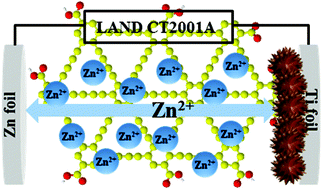In situ grown MnO2/graphdiyne oxide hybrid 3D nanoflowers for high-performance aqueous zinc-ion batteries†
Abstract
Manganese dioxide (MnO2) has been demonstrated to be a promising cathode material for aqueous zinc-ion batteries (ZIBs) due to its low cost, good safety and high output voltage; however, it suffers from an intrinsically low electrical conductivity, poor rate performance and rapid capacity deterioration. Herein, a new kind of MnO2@GDYO hybrid three-dimensional (3D) nanoflower has been designed and fabricated via the in situ growth of MnO2 in graphdiyne oxide (GDYO) nanosheets in aqueous solution. The MnO2@GDYO hybrid 3D nanoflowers have the dual advantages of MnO2 and GDYO, which effectively improve the electrochemical activity and reversibility, increase the ion-/electron-transport channels and enhance the structural stability. Meanwhile, the unique 3D nanoflower structure has large specific surface area, shortens the ion-transport distance and improves the electrochemical reaction kinetics. The rechargeable aqueous Zn//MnO2@50GDYO battery presents an admirable capacity of 253.7 mA h g−1 at 1C, a superior rate capacity of 80.6 mA h g−1 at 10C, and excellent operating stability over 1000 cycles at 5C with a capacity retention of 77.6% and a coulombic efficiency approaching 100%. The facile preparation and excellent electrochemical performance make hybrid-based graphdiyne oxide a promising candidate as a cathode for high-performance ZIBs.

- This article is part of the themed collection: Graphyne


 Please wait while we load your content...
Please wait while we load your content...